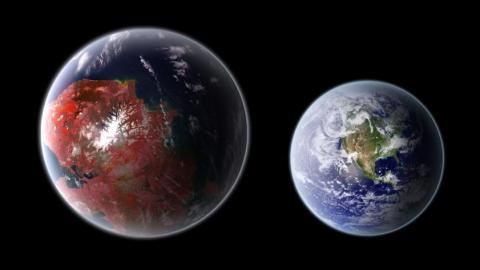New study darkens hope for Earth-like planets

Ph03nix1986 / Wikimedia Commons (CC BY-SA 4.0)
- A new study examines if exoplanets get enough stellar radiation to support photosynthesis.
- Many planets within the habitable zones of stars do not receive enough energy to support plant life.
- Earth-like planets are probably very rare.
Since 1961, astrobiologists and others interested in finding extraterrestrial life have used the Drake equation to speculate on the possible number of technologically advanced alien civilizations in the Milky Way. By multiplying factors like the number of new stars in the galaxy per year, how many planets those stars have, the number of planets suited to life, and how long intelligent civilizations emit radio waves, one can get an estimate of how many other intelligent species are out there right now.
The problem is that the equation is almost entirely speculative because many of the factors have unknown values. But every once in a while, new information helps to narrow down the range of reasonable values to plug in.
Bad news for E.T. enthusiasts: a new study published in Monthly Notices of the Royal Astronomical Society offers a further narrowing of those values. By examining the conditions needed for photosynthesis, the authors propose that biospheres suitable for life might be rarer than we thought.
Let there be (a little more) light
The study’s authors looked at what conditions are needed for the biochemical process that makes most life on Earth possible, oxygenic photosynthesis. By combining carbon dioxide with water and light, species capable of oxygenic photosynthesis produce sugar and oxygen. The latter is released as a waste product.
The authors, like many before them, conjecture that photosynthesis is common throughout the galaxy on account of how much stellar radiation there is to collect, the (comparative) simplicity of the process, and the abundance of the other input elements.
Unlike others before them, they set out to see if any known exoplanets in the habitable zones of their stars actually got enough photosynthetically active radiation (PAR) — a term for solar radiation in the wavelength range between about 400 and 700 nm that most plants can use — to support life. By analyzing how much PAR known exoplanets are getting from their stars, the researchers were able to estimate which of them are getting enough stellar energy to have an Earth-like biosphere filled with photosynthesizing plants.
As it turns out, good real estate is hard to come by in the Milky Way.
Stars that burn at half the heat of the sun do not provide enough energy for a rich biosphere to ever arise. Red dwarf stars, which are small, numerous, and burn at about a third of the sun’s temperature, were even worse. They couldn’t provide the energy needed for much photosynthesis at all.
This is a particular issue for the search for alien life. As lead author Prof. Giovanni Covone of theUniversity of Naplesexplained:
“Since red dwarfs are by far the most common type of star in our galaxy, this result indicates that Earth-like conditions on other planets may be much less common than we might hope. This study puts strong constraints on the parameter space for complex life, so unfortunately it appears that the ‘sweet spot’ for hosting a rich Earth-like biosphere is not so wide.”
On the other end of the scale, very large and bright stars do produce enough light to drive photosynthesis. However, these stars also run out of fuel and either burn out or explode before advanced life would have a chance to evolve.
The Rare Earth hypothesis
Aliens biology: How much do we know? | Michio Kaku, E.O. Wilson, & more | Big ThinkThis doesn’t mean that we are alone in the universe. While the study does suggest that the number of planets suitable for life is lower than we thought, the number is not impossibly small. The authors mention the existence of some planets, such asKepler-442b, which do get enough solar radiation to sustain an Earth-like biosphere.
The study supports the argument known as the “Rare Earth hypothesis.” It is, as the name suggests, the idea that planets like Earth — that is, planets that have the right combination of factors for complex life to evolve — are comparatively rare in the cosmos. (Those who object claim that life could evolve in ways unknown on Earth.)
The hunt will continue for alien life. Just don’t get your hopes up.





